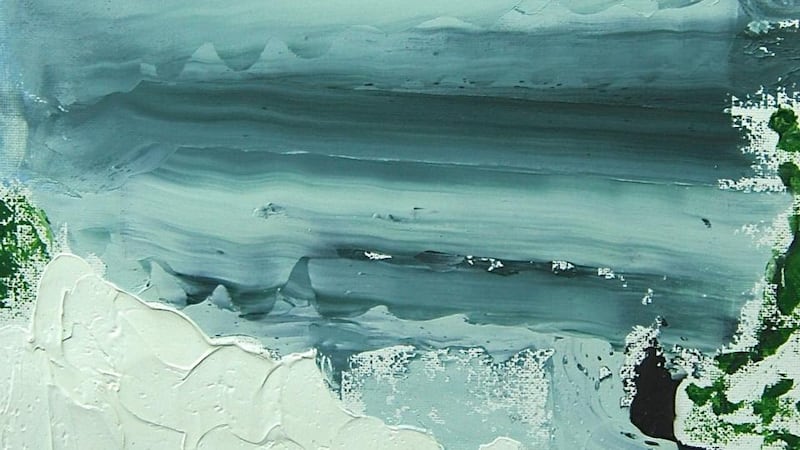Imitation of Life – Amie Siegel
Temple Bar Gallery, Dublin
*****

The essay film, neither fiction nor documentary in the conventional sense, is a form that was developed, from early in cinema, by the likes of Dziga Vertov, Chris Marker, Jean Vigo, Chantal Ackerman and Harun Farocki.
The form always blurred the line between cinema and visual art. Eventually artists from the visual side of that line began to cross over en masse as they saw its potential. Now the fine-art essay film is one of the dominant forms in visual art.
Since her studies at Bard College and the Art Institute of Chicago, the work of acclaimed Chicago-born artist Amie Siegel has encompassed photography, installation, video, film and performance. From the beginning, the essay film (including feature-length films such as DDR/DDR, which was recently screened at the IFI) has been her preferred form.
Her first solo exhibition in Ireland, curated by Megs Morley, features two essay films: Quarry and The Architects.
The logic behind the show's title, Imitation of Life, is not immediately obvious, but, if you watch Quarry from beginning to end – a little over half an hour, and time well spent – the title begins to make sense. Or at least it makes sense if the allusion is not so much to Douglas Sirk's 1959 anti-racist melodrama per se as to the artifice of Hollywood and film generally, where sets and visual effects such as mattes are routinely employed to generate an illusion of reality. And the plot of Imitation of Life involves deception and misrepresentation of a different kind.
For its first half or so, Quarry is set in the celebrated "gallery quarries" near Danby, Vermont, where marble is quarried from vast caves tunnelled into the Green Mountains, the largest underground marble quarry in the world. The marble is cut in huge, regular oblong blocks and extracted for slicing and honing. Within the quarried caves, the rectangular patterning of the cuts and the beauty of the pale stone create majestic spaces.
The scale of the operation is mind- boggling. The tremendous masses, weights and forces involved, as diamond chainsaws cut out the blocks and huge machines struggle to manoeuvre them before they are processed into pristine slabs, cannot but inspire some level of wonder both for the magnificent material and the engineering skills involved in the quarrying.
What could top that? Well, nothing. Siegel abruptly switches to views of where the sheets of marble are destined to be installed. We see a succession of high-end luxury apartment interiors in Manhattan, fitted out with the liberal use of marble and other expensive materials. There are various views over the city. And yet, something is not quite right. After the visual solidity of the first half in the quarry, there is something vague and nebulous about these Manhattan palaces.
What’s wrong is that they are not only show apartments, with a sense of falsity about them, but they are actually mock-ups of show apartments. The builders of speculative blocks aim to sell their apartments before they are built, so they install mock-ups of what they are building in existing blocks. They also employ a mixture of old and new technology to fabricate a sense of what the new apartments will be like, including simulations of the views to be seen from different levels of the buildings.
We are looking at fabricated sets, interiors that are intended to convey aspirational images of opulence – looking, in other words, at imitations of life. In the midst of all this is a magnificent material wrested from nature, which Siegel has referred to as being "alienated". There is no moralising commentary, no commentary at all, in fact, although extracts from Holst's The Planets are deployed in a way that suggests something is amiss.
There is no commentary in the other work in the show either, just the indistinct snatches of conversation among the architects we see at work in several offices in Manhattan and Brooklyn. The video is nothing more than a series of slow tracking shots through the offices and studios, but it is curiously compelling and fascinating. Apart from the chance to see a succession of generally cool, stylish workplaces (with some very nice chairs, for example) we are looking into where the plans for all those speculative builds take shape. Again, a wealth of industry and ingenuity is applied to a questionable end. Both pieces are visually sumptuous and conceptually rich, and set ideas in motion without telling us what to think.
[ templebargallery.comOpens in new window ]
Source – Eddie Kennedy
Hillsboro Fine Art, Dublin
****
In the past, two opposite and alternating impulses have been evident in Eddie Kennedy's paintings. One is a desire to pin things down, to definitively fix an image, and the other is to trust the flux, to accept the impossibility of pinning anything down. Insistent patterning and framing have served the purposes of fixity. What works for flux? Visit his show Source and he answers that question.
Kennedy was born in Thurles, Co Tipperary, studied at Limerick School of Art and Design, completed an MA in Cincinnati and lived in New York for a time before returning to settle in Ireland. Here he apparently splits his time between Dublin and Mayo.
The evidence suggests that his heart, or the heart of his work, is in Mayo, by the sea. The endless movement of the sea, and the restlessness of the light, inform his recent paintings. They have a buoyant lightness, an air of being caught on the wing, or being, in de Kooning’s phrase, “slipping glimpses”. Even the mass of Nephin Beg, filtered through haze and mist, becomes a shimmering, holy mountain. It’s a bold, optimistic show.



















